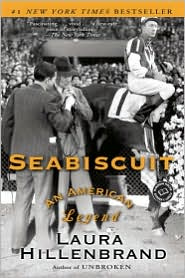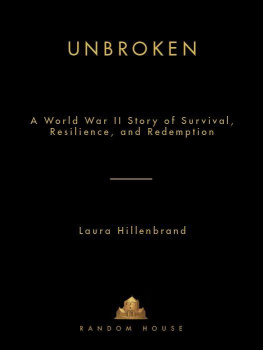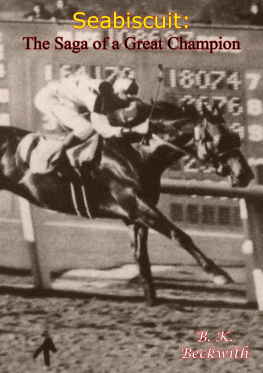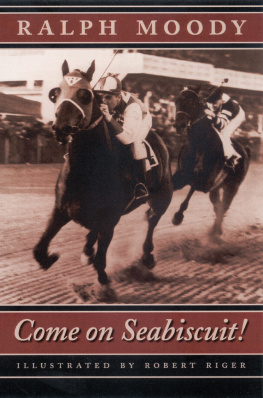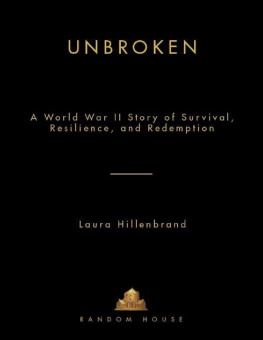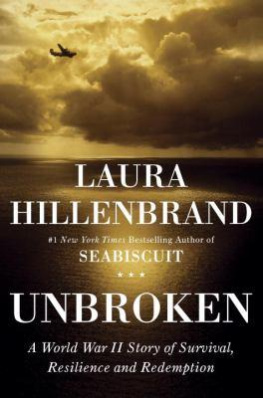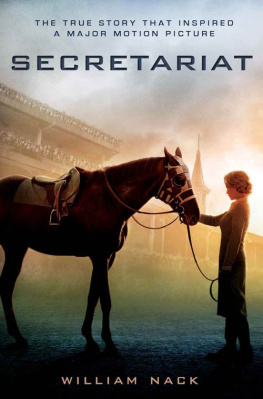Laura Hillenbrand - Seabiscuit: An American Legend
Here you can read online Laura Hillenbrand - Seabiscuit: An American Legend full text of the book (entire story) in english for free. Download pdf and epub, get meaning, cover and reviews about this ebook. year: 2001, publisher: Ballantine Books, an imprint of The Random House Publishing Group, genre: Detective and thriller. Description of the work, (preface) as well as reviews are available. Best literature library LitArk.com created for fans of good reading and offers a wide selection of genres:
Romance novel
Science fiction
Adventure
Detective
Science
History
Home and family
Prose
Art
Politics
Computer
Non-fiction
Religion
Business
Children
Humor
Choose a favorite category and find really read worthwhile books. Enjoy immersion in the world of imagination, feel the emotions of the characters or learn something new for yourself, make an fascinating discovery.
- Book:Seabiscuit: An American Legend
- Author:
- Publisher:Ballantine Books, an imprint of The Random House Publishing Group
- Genre:
- Year:2001
- Rating:4 / 5
- Favourites:Add to favourites
- Your mark:
- 80
- 1
- 2
- 3
- 4
- 5
Seabiscuit: An American Legend: summary, description and annotation
We offer to read an annotation, description, summary or preface (depends on what the author of the book "Seabiscuit: An American Legend" wrote himself). If you haven't found the necessary information about the book — write in the comments, we will try to find it.
Seabiscuit: An American Legend — read online for free the complete book (whole text) full work
Below is the text of the book, divided by pages. System saving the place of the last page read, allows you to conveniently read the book "Seabiscuit: An American Legend" online for free, without having to search again every time where you left off. Put a bookmark, and you can go to the page where you finished reading at any time.
Font size:
Interval:
Bookmark:

NUDE PHOTOS AID SCIENCE
If you found yourself in a red-light district in the spring of 1951 and you had a spare quarter, you could purchase SIR! A Magazine for Males and read the story behind this cover headline. The magazine was the strangest of hybrids, a girlie gazette straining to pass itself off as a scientific journal. As pornography, it was a crashing failure. The featured model in an article on Latin Quarter Lovelies is shown hopping around in nothing but four one-quart-capacity Egyptian fezesonly one of which is on her headwith pasties stuck to the bottoms. The cover story asserts that corpulent people tend to be jolly and helpfully offers shots of nude models as proof. In another piece, PURE SCIENCE UNCOVERS ANCIENT VICE, the lifes labors of a University of Chicago classics professor are distilled into a discussion of how The Antics of the Ancient Greeks Would Make Modern Playboys Drool with Envy. Somehow the magazine endured, thanks to advertising from rupture control companies and a pharmaceutical outlet that sold thirty days worth of genuine Male Sex Hormones in a plain brown wrapper for $5.
SIR! came to grace my bookshelf after I typed the name George Woolf into an Internet auction search engine and turned up the magazine as a match. I didnt have much hope for it, but the mystery of how an unpornographic, unscientific jockey landed in a pseudo-scientific porn magazine got the best of me. I shelled out $2.50 and gave SIR! a home. When it arrived, I flipped through and discovered, sandwiched between the trusses and jolly jiggling women, a wealth of tales of the Icemans exploits: setting his tack on fire, sleeping on the jocks room roof, riding pantsless down a homestretch before a grandstand full of fans. I called Woolfs old friends and asked them about the stories. They verified all of them and even provided details the magazine had missed. SIR! had merit after all.
Writing this book has been a four-year lesson in how history hides in curious places. I obtained the narratives basic framework from the usual suspectsnewspapers in the Library of Congress and other archives, official track chart books, racing histories, magazines. But the narrative they offered, though intriguing, was incomplete. The textures of my subjects personalities, their complex relationships, motives, fears, thoughts, and secrets, all remained elusive, as did the small but telling details that give historic figures immediacy and resonance in the imagination. My subjects had long since died, but I was convinced that they must have left behind some detritus. I began prowling Internet search engines, memorabilia auctions, and obscure bookstores, writing letters and placing information wanted ads, and making hundreds of calls to strangers in hopes that someone or something could illuminate what seemed to be a lost past.
The story wasnt lost. It was scattered all over North America, tucked in back pockets and bottom drawers. A remarkable quantity of information came from an odd assortment of memorabilia, most purchased, some borrowed from a proselytizing sect of collectors. A few items were bad investmentsa disco tribute to Seabiscuit springs to mindbut most yielded something of value, sometimes a note that gave an added dimension to a man, sometimes a forgotten anecdote or a critical explanation. In faded magazines and moldy newspapers I discovered rare photos, long interviews with my subjects, conversations between them, and exhilarating eyewitness accounts of events in their lives. My subjects private lives and the world they inhabited unfolded in the pages of almost a dozen forgotten autobiographies of horsemen stretching back to 1913 Kentucky Derbywinning rider Roscoe Goose. On a crackling audiotape I heard George call out to Red from the back of Seabiscuit, standing in the midst of a roaring throng. A 1945 Jockeys Guild yearbook found in a Virginia bookshop yielded details on Frenchy Hawley and the stomach-turning mechanics of reducing. I unearthed Seabiscuits signature board games, pinball machine, wastebasket, postcards, and endorsement ads for two beer brands, two lines of Seabiscuit oranges, whiskey, a hotel, a humor magazine, a dry-cleaning service, and ladies hats. I was the only bidder in an auction for what turned out to be a rare film of the SeabiscuitWar Admiral match race, one of a half-dozen race films and newsreels I was able to obtain.
My greatest source was living memory. An ad placed in the Daily Racing Form on Breeders Cup day yielded a stack of letters. At least ten were written on the backs and in the margins of tip sheets and racing programs. One was composed in crayon on a slip of paper torn into a rough hexagon. Nearly all were penned in the sweeping Victorian script of a lost age. I picked up the phone and started calling these people and the hundred or so potential sources I found through racing contacts. Once or twice, my call wasnt well received. How old do you think I am? snapped an angry octogenarian when asked if he had known any of the Seabiscuit crew (he died of old age a few months later). Some were a little too eager to talk. You sound like a young girl! a gravely ninety-something man thundered into the phone. I like young girls! Some told me more than I ever imagined, like the aged horseman who described his bodice-ripping romps with the Molino Rojo girls, then asked me not to print his name cause my ex-wives might not like it. Most of the time, my interviewees welcomed me into what one source called those dear, dead days and allowed me to linger as long as I wished.
The luxury of researching those who achieve the extraordinary is that their lives play out before many observers. I spoke with people who saw Red Pollard hitch his toboggan to his pony, tumble down under Fair Knightess, spout Shakespeare and throw fists in the jocks room, draw his last breaths in a nursing home built on the ruins of a track on which he once rode. I followed Woolf through the memories of friends, from a grade school classmate to a man who saw him die and sat vigil over his body on the day of his funeral. I found a groom who handled Seabiscuit for Fitzsimmons, the boys who galloped him for Smith, and several dozen witnesses to his races. I was even contacted by a nearly hundred-year-old former groom living in a telephoneless trailer in the desert, who is evidently the last person on earth who recalls the Lone Plainsman telling of his youth on the mustang ranges. The Detroit cemetery worker; the wife speaking for a husband muted by a stroke; the ancient trainer living through his last summer tethered to an oxygen tank; the clerk at a mail-order seafood company; the operator of the Seabiscuit liquor store in Hercules, California: each had something to contribute. Again and again, when I was able to check their testimony against records kept at the time, the accuracy of their statements was verified: the color of War Admirals blanket, the precise time of Seabiscuits half-mile split, a quip Red made seventy years ago. Ultimately, I gathered an almost uninterrupted memory record of the story I wished to tell from those who recall the sound, the smell, the feel of it, and who divulged secrets, such as Reds blind eye, that finally solved mysteries more than half a century old.
T he completion of this book is tinged with sadness, as several of those who helped create it didnt live to see it in print. Among them was Sonny Greenberg. A bug boy with Red Pollard and George Woolf, Sonny was, he cheerfully admitted, a pathologically bad jockey, once steering a horse around a turn with such ineptitude that he lost more ground than when the Indians sold Manhattan for a string of beads and a bottle of whiskey. Sonny may not have had Woolfs skill, but he was an astute observer of life in the Howard barn and racing in its golden era. Putting up with at least seven hours of my questions, Sonny animated life in Seabiscuits timethe purr of Woolfs blue Cord roadster, the torment of reducing and the taste of jalap, the wicked, misunderstood humor of Tom Smith. Sonny, who in racetrack lingo told me that his advanced age left him on the also eligible listI could draw in at any time, drew in on May 6, 2000. It was Derby day.
Font size:
Interval:
Bookmark:
Similar books «Seabiscuit: An American Legend»
Look at similar books to Seabiscuit: An American Legend. We have selected literature similar in name and meaning in the hope of providing readers with more options to find new, interesting, not yet read works.
Discussion, reviews of the book Seabiscuit: An American Legend and just readers' own opinions. Leave your comments, write what you think about the work, its meaning or the main characters. Specify what exactly you liked and what you didn't like, and why you think so.

